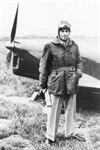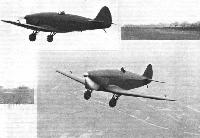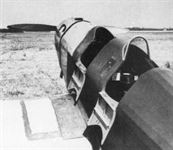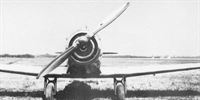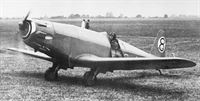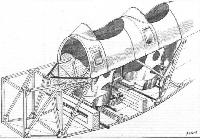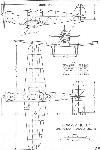
Flight, April 1934
THE COMPER "STREAK"
LT. COMPER and those associated with him are to be congratulated on their enterprise in challenging the French constructors for the Deutsch de la Meurthe Cup. With the withdrawal, announced last week, of the Italian entries for, it is believed, the reason that the machines and engines could not be sufficiently developed and tested in time for the contest, Great Britain will be the only non-French challenger, and the Comper "Streak" will be the only British entrant. What makes the British challenge so courageous is the fact that the "Streak" is fitted with the de Havilland "Gipsy Major" naturally-aspirated engine, which is of but 6.125 litres capacity, while the French machines will be able to call upon all the power that can be got from supercharged engines of the full 8 litres capacity permitted by the Coupe Deutsch regulations. This means that Comper will have to face competitors with more than twice his power at their disposal. Comper's performance estimates indicate, however, that his machine should not be nearly so inferior to the French as the difference in power might lead one to imagine. The effect of engine power is cumulative, and the larger and more powerful engines require correspondingly more fuel in a given time, which means that the machine itself must be larger and of greater wing area if the landing speed is to be kept down to reasonable limits. Everyone in British aviation will wish Flt. Lt. Comper all possible good fortune in his plucky attempt to wrest the Coupe Deutsch from the French defenders.
Last year Flt. Lt. N. Comper, Chief Engineer and Technical Director of the Comper Aircraft Co., Ltd., put a "hotted up" "Gipsy Major" engine into one of his little high-wing monoplanes, and in the face of very great handicap and serious competition raced it for the Coupe Deutsch de la Meurthe in France. The story of his gallant fight was recorded in FLIGHT for June 8, 1933. In our issue of FLIGHT for May 11, 1933, we were able to publish a general arrangement drawing showing a development of a new machine called the "Streak," designed chiefly for races of this nature - which, incidentally, Flt. Lt. Comper's experience in France had shown him to be desirable. The original "Streak" was, we believe, designed with the idea of competing in the International Air Races which a committee attempted to organise at Portsmouth last year. Unfortunately, these races did not mature, and the "Streak" never, therefore, came out. This year Flt. Lt. Comper has again decided to compete in the French event, and on Thursday, April 12, the machine was flown successfully.
During the first flight of the "Streak," made by Flt. Lt. Comper himself, the new machine proved itself perfectly balanced, and it was found that control and stability were good. One possible exception was formed by the ailerons, which were found to be surprisingly sensitive. So much so, in fact, that flutter developed. In this connection it should be pointed out that the mass balances designed for the ailerons had not yet been fitted, and it may be that when this has been done the trouble will disappear. The flutter occurred at high speed only, and modern theory indicates that in nearly all cases a tendency to flutter can be cured by mass balances.
Since January, 1930, when we were able to publish the first full description of the Comper "Swift," which at that time was fitted with the A.B.C. "Scorpion" engine, a great deal of development has taken place. As our photographs show, subsequent development was the production of a "Swift" with a Pobjoy engine, then a "Swift" with a "Gipsy Major" engine, and more recently a low-wing high-performance monoplane called the "Mouse" (see FLIGHT for September 28, 1933).
Flt. Lt. Comper, with his Technical Assistant, Mr. A. A. Fletcher, have by their experience with this latter machine, been able to produce the "Streak," and this machine is in effect a modified "Swift" fuselage put on to a scaled-down "Mouse" wing. The result is a very up-to-date high-performance machine, which may equally well be used for racing or for the fast transport of things like Press photographs. Points which will immediately be noticed, besides the general clean lines, are the retractable undercarriage and the modification of the top decking of the fuselage behind the "Gipsy" engine, to new curved lines. As in the "Mouse," the wheels of the undercarriage are stowed slightly below the bottom of the wing when the undercarriage is retracted, forming an excellent safety device in the case of forced landings on soft or bad ground. The "Mouse" has already been landed with the wheels retracted without any damage whatsoever other than bending the airscrew tips, and even that may be avoided if the airscrew is so mounted that it stops in the horizontal position. Landing the machine like this, while it is true it may result in slight damage to the bottom of the fuselage, does remove any possibility of the machine turning over and damaging the occupants, a matter of no small importance in the case of the "Streak," which has a wing loading as high as 18.75 lb./sq. ft. (91,54 kg./m2).
Structurally the fuselage differs in its main essentials very little indeed from the "Swift." It consists of spruce longerons, rigidly braced by spruce struts in W form with three-ply gussets of ample size, and the whole is fabric covered. Modifications have, of course, been made to the bottom longerons in the centre portion of the fuselage, where it is placed over the wing.
The fairing over the rear part of the fuselage is of doped fabric over a light framework of spruce stringers. Between the fireproof bulkhead and the pilot's windscreen a sheet aluminium cover over the main fuel tank forms the top front decking and continues an excellent line back from the engine fairing.
The wing is made up as a complete unit with box-section plywood and spruce spars; an ingenious joint allows the webs to be continuous, although the centre portion of the spar is horizontal and the outer portions of the wing beyond the undercarriage housings are turned up to give a 5 deg. dihedral angle. The ribs have solid three-ply webs with double spruce booms, and the three-ply covering over the whole wing removes any necessity for separate drag bracing. The ribs on either side of the undercarriage recesses are of laminated spruce, and steel tubes carry the drag stresses in the region of these recesses. The aileron spars are channel section spindled from spruce, with a three-ply web across the jaws of the channel. The ribs are constructed much in the same way as those of the wing, and a three-ply covering is also used. Our sketch shows the small fibre gear wheels in the wing which transfer the motion of the aileron control cables from the control column via external rods and levers to the ailerons themselves.
The tail plane has spindled spruce spars, spruce and plywood ribs and is fabric covered, the elevator also being of the same construction. The rudder and fin, however, have steel tube posts with flanged steel plate ribs, spot welded to sleeves which are pinned to the posts, the leading edge and trailing edge also being steel tubes. The controls are by cross-shafts, rocking levers and cables, following normal practice. The tail skid is a straightforward one composed of leaf springs. In the pilots cockpit a large dashboard carries the usual range of Smith's instruments, including one of their latest Turn and Bank Indicators, and a Reid & Sigrist pitch level.
Our artist's impression of the centre-section, which carries the pilot's controls, shows how well placed are items like the operating handle for the undercarriage on the starboard side and the brake lever on the port side. In order to assist the pilot as much as possible without increasing the drag of the machine, transparent windows have been let in either side of the fairing below the wind-screen, and by them his view is quite considerably enhanced.
The engine mounting, carrying the special "Gipsy Major" engine, is a straightforward one of square-section welded steel tubes. The fuel system consists of a central tank mounted in the fuselage in front of the pilot, carrying 29 gall. (132 litres), and two wing tanks in the centre portion of the wing either side of the fuselage, having a capacity of 8 1/2 gall. (38.6 litres) capacity each. The engine is supplied with fuel by dual pumps of de Havilland manufacture. The cowling round the engine is of sheet aluminium. It is particularly neat and gives the fore part of the machine very clean lines, at the same time providing adequate cooling. The side panels of the cowling are on vertical hinges at the front end and are secured, as are the top and bottom detachable panels, by the new Thompson-Boothby cowling clip. The oil tank, in keeping with Comper practice, is cooled by a direct air inlet on the port side, carrying cold air from the outside of the machine through a tube running through the middle of the tank, and exhausted by a vent placed where the starboard wing root joins the fuselage. The engine drives a Fairey metal propeller.
The undercarriage differs but slightly from that fitted in the Comper "Mouse." Only one compression leg is fitted either side of each wheel, and these legs are of the type now so well known, which is designed and manufactured by Mr. G. H. Dowty, of Aircraft Components Co., Cheltenham. Our artist's sketch explains clearly the neat manner in which the locking pins are withdrawn when it is desired to raise the landing gear. Each unit comprising the structure carrying the compression legs and ultimately the wheel itself is, of course, entirely separate from the other except that a cross shaft enables the sprocket and chain drive in the cockpit to raise and lower both wheels simultaneously. Dunlop wheels and tyres are fitted, the former being the A.H.6 16-in. type and the latter 6-in. by 6 1/2-in. medium pressure, and the brakes are Bendix.
Описание:
- Flight, April 1934
THE COMPER "STREAK" - Flight, May 1934
A NEW SPORTS MODEL - Flight, July 1934
NEW AEROPLANES IN KING'S CUP RACE
Фотографии
-
Aeroplane Monthly 1977-01 / R.Riding - Comper Streak /British pre-war ultralights/
The Streak shortly after roll-out at Heston in April 1934, before the fitment of mast balances
-
Aeroplane Monthly 1977-01 / R.Riding - Comper Streak /British pre-war ultralights/
CLEAN LINES: The "Gipsy Major" engine of the Comper "Streak" has been very cleanly faired in, but the cowling at the same time provides adequate cooling. Another view of the Streak before the addition of mass-balances.
-
Flight 1934-04 / Flight
RACY LOOKING: The two views of the new Comper "Streak" bring out the racy lines of this machine.
-
Flight 1934-04 / Flight
The head-on view, more particularly when the landing gear is retracted, shows how clean it is possible to get a machine of this nature.
-
Aeroplane Monthly 1977-01 / R.Riding - Comper Streak /British pre-war ultralights/
J. Graham, Comper works manager, surveys the Streak, with Comper sitting in the cockpit, at Heston in April 1934.
-
Flight 1934-05 / Flight
THE COMPER "STREAK": In a recent issue of "Flight" we reported that a certain amount of aileron flutter had arisen. By giving ailerons a very narrow chord and fitting mass-balances, as indicated by the illustration, the trouble has completely disappeared.
-
Aeroplane Monthly 1977-01 / R.Riding - Comper Streak /British pre-war ultralights/
Регистрационный номер: G-ACNC [4] Flt Lt Nicholas Comper at the age of 36, about to demonstrate the Streak for Flight’s photographer.
-
Aeroplane Monthly 1977-10 / R.Riding - Comper Kite /British pre-war ultralights/
Nicholas Comper was born in London in 1897 and flew B.E.2Cs with the RFC in France. He was responsible for the Cranwell Light Aeroplane Club designs of the 1920s, and in 1929 he formed the Comper Aircraft Company at Hooton Park. After its demise in 1934 Comper became an aeronautical consultant until his tragic death at Hythe in June 1939.
-
Flight 1934-04 / Flight
ROOT DETAILS: The finished "Streak" will in all probability be heavily filleted at the wing roots. Near the leading edge can be seen the exhaust for the cooling air which is led through the oil tank. The windows in the sides of the pilot's cockpit should also be noted.
-
Aeroplane Monthly 1977-01 / R.Riding - Comper Streak /British pre-war ultralights/
Photo shows Flt Lt Nicholas Comper flying the Streak shortly after mass-balances were added to the ailerons.
-
Flight 1935-09 / Flight
This Comper Streak, which has a retractable undercarriage, may be the fastest machine in its class. It is to be flown by P. de W. Avery (No. 8).
-
Aeroplane Monthly 1977-01 / R.Riding - Comper Streak /British pre-war ultralights/
The Streak demonstrates its smart take-off capabilities at Heston.
-
Aeroplane Monthly 1977-01 / R.Riding - Comper Streak /British pre-war ultralights/
Регистрационный номер: G-ACNC [4] The Streak, bearing civil registration G-ACNC, makes a low flypast at Heston in April 1934 for the benefit of Flight’s photographer. Note how the retracted wheels protrude, and the glazed panel just below the windscreen affording the pilot additional vision forward and downward.
-
Aeroplane Monthly 1977-01 / R.Riding - Comper Streak /British pre-war ultralights/
Регистрационный номер: G-ACNC [4] The Streak at the time of the 1935 King’s Cup race. Note the addition of undercarriage doors - presumably an attempt to coax extra knots out of the racer.
-
Aeroplane Monthly 1977-10 / R.Riding - Comper Kite /British pre-war ultralights/
Another view of the factory-fresh Kite at Heston.
-
Aeroplane Monthly 1977-10 / R.Riding - Comper Kite /British pre-war ultralights/
The neat and compact cockpits of the Kite, the forward one minus windshield.
-
Aeroplane Monthly 1977-10 / R.Riding - Comper Kite /British pre-war ultralights/
The Kite at Heston on July 11, 1934, shortly after completion and still in its primer dope.
-
Aeroplane Monthly 1977-10 / R.Riding - Comper Kite /British pre-war ultralights/
The 90 h.p. Pobjoy Niagara seven-cylinder air-cooled radial engine weighed 150lb minus exhaust system, cowlings and propeller and developed 90 h.p. at 3,500 r.p.m. The 1934 King’s Cup Race was won by a Monospar powered by two Niagaras.
-
Aeroplane Monthly 1977-10 / R.Riding - Comper Kite /British pre-war ultralights/
Types of Machine in the King's Cup Race (4) Comper "Kite," Pobjoy "Niagara" 90 h p engine.
-
Aeroplane Monthly 1977-10 / R.Riding - Comper Kite /British pre-war ultralights/
The Comper Kite, with Flt Lt E. H. Healy at the controls, moments before taking off in Heat 1 of the King's Cup Race at Hatfield on July 14, 1934. The front cockpit was faired over for this event.
-
Aeroplane Monthly 1977-10 / R.Riding - Comper Kite /British pre-war ultralights/
Another view of the Kite at Hatfield on July 14, 1934.
-
Aeroplane Monthly 1979-12 / Skywriters
Регистрационный номер: G-ACNC [4] A 1/4-scale radio-controlled model of the Comper Streak.
-
Flight 1934-05 / Flight
A COMPOSITE PICTURE: Showing how the "Kite" will look when flying.
-
Flight 1934-05 / Flight
NEW SEATING ARRANGEMENT: The additional bay to carry the new engine mounting for the Pobjoy "Niagara" is also shown.
-
Flight 1934-07 / Flight
DESIGN AIDS TO SPEED (4) Shows how Flt. Lt. Comper arranges the aileron balance and pilot head on the wing tip of his "Kite."
-
Flight 1934-07 / Flight
DESIGN AIDS TO SPEED (7) On the rudder of both his "Streak" and "Kite," Flt. Lt. Comper arranges the mass balance as an arc working through a slot in the fin.
-
Flight 1934-07 / Flight
COMPER'S UNDERCARRIAGE: Both the Comper "Streak" and the new Comper "Kite" have their undercarriages retracted straight back by mechanical means.
-
Flight 1934-04 / Flight
RETRACTABLE: On the right is a perspective sketch showing the general details of one side of the retractable landing gear, and on the left is the mechanism whereby the locking pins are withdrawn preparatory to raising the landing gear.
-
Flight 1934-04 / Flight
FUSELAGE DETAILS: In these sketches our artist brings out very clearly the constructional details of the central portion of the fuselage. On the right, the lever which raises and lowers the undercarriage.
-
Flight 1934-04 / Flight
Comper "Streak" Gipsy "Major" Engine
-
Flight 1934-05 / Flight
Comper "Kite" 90 hp Pobjoy "Niagara" Engine
- Фотографии







